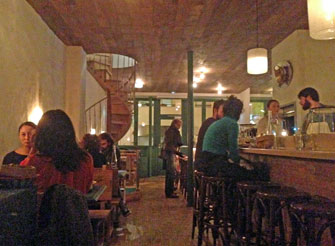
Naming a Paris restaurant after an American juice product, Clamato (a mixture of clam and tomato juices, as the name suggests), may seem a bit odd, but there you have it. And when you know that this is the fish annex of chef Bertrand Grébaut’s brilliant Septime next door, you don’t worry too much about it.
Clamato has all the attributes seen in trendy new Paris restaurants: a bar where diners can eat on high stools; small plates to be mixed and matched rather then the traditional starter, main course and dessert; a friendly, youthful staff; high standards for ingredients; and plenty of creativity in the kitchen.
The decor is fairly minimalist, another common trait, but Clamato has a warmer, cozier atmosphere than many, with a spiral staircase, parquet on both the ceiling and floor, quirky light fixtures, candles on the tables and colorful sparkling fairy lights visible through the big window looking onto the courtyard garden. Noise levels are reasonable. As in all trendy restaurants in Paris, the restroom is equipped with delightful (and expensive) Aesop soap and real hand towels.
The stage was set for an enjoyable meal, and the promise was more than met. The menu starts with a selection of rather pricey oysters (€16-€19 for six) and cherrystone clams (€17 for four). We wanted something that would better show off the cook’s talents, however, so we asked the young, bearded waiter with a dry sense of humor to make a few suggestions.
We started with three dishes he recommended, all served on enameled metal plates. First came the only non-fish dish on the menu: slices of barely cooked beef with anchoïade and little
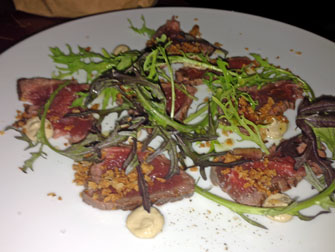
dabs of green mustard. Perfect. The sauce of anchovies, capers, olive oil and garlic enhanced without overwhelming the delicate flavor of the meat, and toasted bread crumbs added a bit of crunch.
The second dish was a fish we were unfamiliar with: “chinchard de la nuit,” which, as far as I can tell, is called horse mackerel in English. It was served as a ceviche in its citrusy sauce

speckled with delicious toasted hazelnuts and topped with crunchy, paper-thin slices of raw kohlrabi. Fresh and flavorful. We then had some smoked haddock of perfect quality served
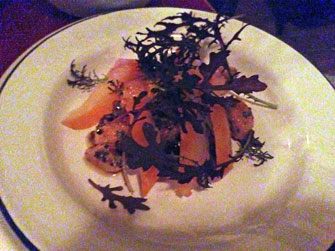
with tapenade, the least exciting of these three dishes but still very fine.
From the list of hot dishes we selected the pétoncles (small scallops), our favorite dish of all

those we tried – each shell had two plump little scallops on it, drowned in melted herb butter –

and the accrabios, lovely crabcakes with wankaina (spicy mayonnaise).
We tried both the desserts on the menu. My friend Bill and I had an attack of nostalgia for our early days in Paris when our orange givrée arrived. An industrial version of this refreshing
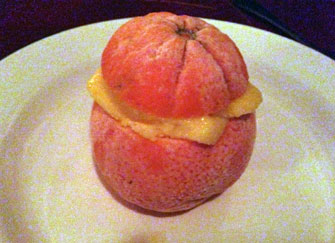
dessert – a scooped-out orange filled with orange sorbet – used to be on the menu of many Parisian restaurants and cafés. This one was homemade and far better, filled not only with sorbet but also with bits of orange and toasted hazelnuts. This would be fabulous on a hot summer day, but we enjoyed it thoroughly on a winter’s evening. The other dessert was a yummy maple-syrup tart with a perfect crust
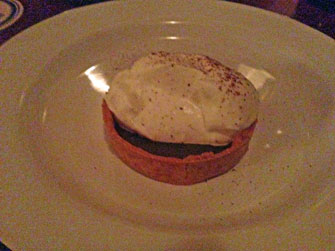
and freshly whipped cream.
The waiter wanted to know what we thought of each dish, but there was no need to fish for compliments – we were willing to give them freely.
Winewise, we took great pleasure in a light, fruity red that nevertheless had plenty of body, the 2013 “Octobre” from Les Foulards Rouge in Roussillon, priced at only €22.
Since the menu changes daily, you can go back every day and try something new. An excellent idea, but go early to be sure of getting a table or a seat at the bar – Clamato does not take reservations. If you don’t get in and are dying for fish, there are plenty of other good, reasonably priced all-fish restaurants – another trend– to try, among them The Fish Club, Edgar and L’Ecailler du Bistrot.
Favorite